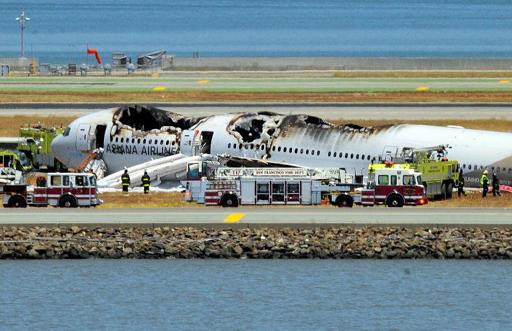US air accident investigators opened a hearing Wednesday into the role that sophisticated cockpit automation might have played in the fiery crash of a South Korean airliner in San Francisco.
Three passengers died when Asiana Airlines Flight 214 clipped a seawall, skidded out of control and burst into flames upon landing after an otherwise routine flight from Seoul on July 6.
Another 182 passengers and crew aboard the Boeing 777 were injured -- and first indications suggested the pilots approached the runway at well below the optimum speed for landing.
"We have the opportunity today to ensure that the lessons of this tragedy are well-learned and that the circumstances are not repeated," NTSB chairwoman Deborah Hersman said, opening the day's proceedings.
The nearly 12-hour hearing was supposed to be a two-day affair, but its scheduled start Tuesday was postponed due to a federal government shutdown prompted by wintry weather in Washington.
Keith Holloway of the National Transportation Safety Board said the hearing will "gather additional factual information" as the agency prepares its report on the first fatal accident involving a Boeing 777.
"Typically it takes about 12 months to complete a full investigation," he told AFP. "This is just one phase, a fact-gathering stage."
None of the four pilots, 12 flight attendants and 291 passengers, many of them South Korean and Chinese nationals, are to testify.
Instead the hearing at an NTSB conference center in Washington will hear expert testimony on such issues as cockpit automation in the Boeing 777 and the training of Asiana pilots in its operation.
It will also dwell on the effects of automation on pilot performance in the moments prior to an accident, airport emergency response and the crashworthiness of aircraft interiors.
All three of the dead were young Chinese women, including one who was fatally hit by a fire engine as she lay stricken near the runway.
Landing just before noon on a clear and sunny Saturday, but with San Francisco airport's instrument landing system reportedly out of service, Flight 214 had been cleared by air traffic controllers for a visual landing on Runway 28 Left.
Amateur video of the moment of impact showed the aircraft's nose up, and its rear hitting the ground first, before it bounced abruptly then spun around 180 degrees, shedding its tail.
Large sections of the fuselage were gutted in the ensuing fire.
On the scene two days later, Hersman said the aircraft was coming in to land at a speed significantly below the 137 knots (158 miles per hour, 254 kilometers per hour) that it should have been holding on final approach.
"We are not talking about a few knots here or there. We're talking about a significant amount of speed below 137," she told reporters.
Initial investigation also found the precariously slow speed triggered the Boeing 777's stall warning system -- a vibration on the controls known as a "stick shaker" -- four seconds prior to impact.
San Francisco airport is among the busiest in the United States, handling more than nine million international and 33 million domestic travelers in the year to June 2012.
Asiana has defended the two pilots at the controls at the time of the July 6 accident, Lee Kang-Kuk and Lee Jung-Min, saying they were "competent" veteran aviators whose experience included dozens of flights to and from San Francisco.
It also said in July that "there were no engine or mechanical problems" on the aircraft, which it acquired in 2006.
Lee Kang-Kuk, a pilot for some 10 years, was midway through training to fly the Boeing 777 and its all-digital instrument panel, known in pilot jargon as a "glass cockpit."
He had 9,700 hours of flying experience, and was transitioning from the Airbus A320 to the Boeing 777, the hearing heard.
Lee Jung-Min, with many flying hours in the "triple seven," acted as co-pilot and a newly-certified instructor.
Two other relief pilots were on board as well -- not unusual for a long transpacific journey that would call for a mid-flight change of cockpit crew.























































